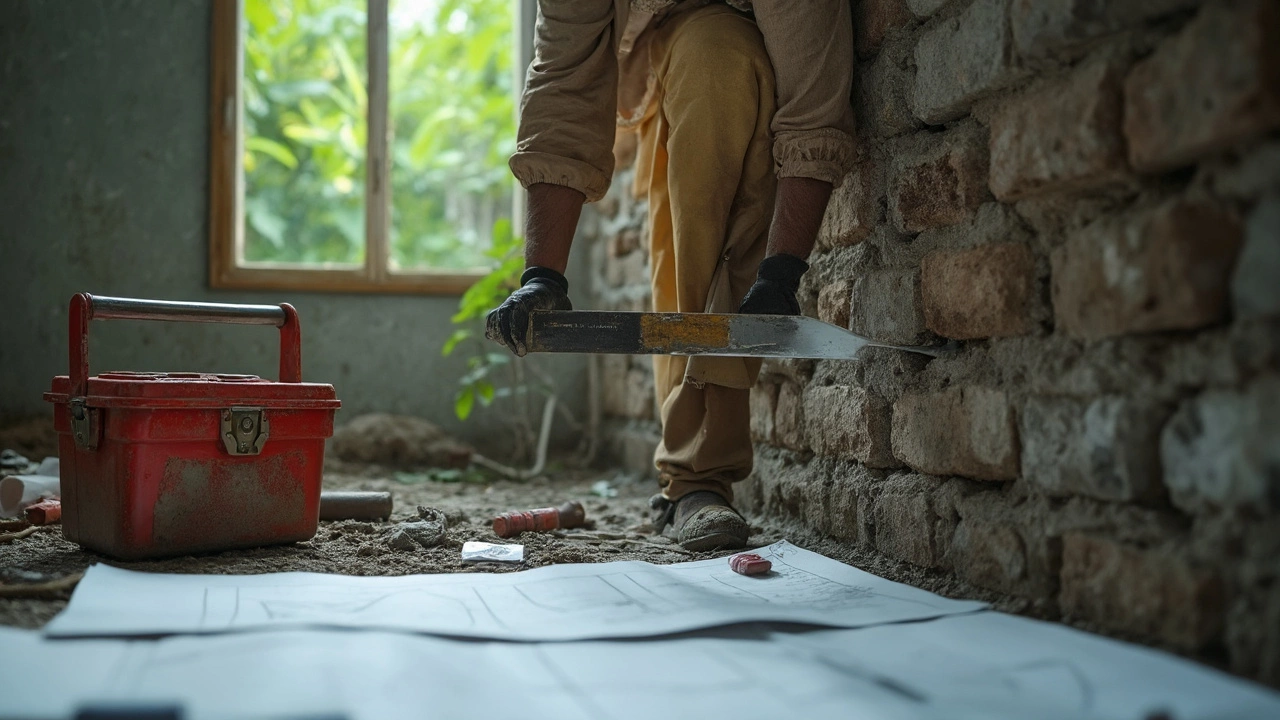If you walk into your basement and squish through a puddle, it’s not a good sign. Foundation leaks from the inside can turn your dream home into a headache fast. First thing: don’t panic—most foundation leaks happen because water is finding a way in through tiny cracks, gaps around pipes, or even poorly sealed basement windows. Rain, melting snow, or even a busted outdoor drain can push water toward your house until it finally finds a way inside.
Before doing anything, take a close look at where the water is coming from—don’t just mop it up and hope for the best. Look for streaks on the walls, warped flooring, or that musty smell that never seems to leave. These are not just signs of water—they’re clues about what’s going on behind your walls. Once you spot them, you’re halfway to solving the problem. Nobody wants mold or rotten framing eating away at their investment, so it pays to act quickly.
- Why Your Foundation is Leaking from the Inside
- Spotting the Signs Before It Gets Worse
- What Actually Works for Stopping the Leak
- DIY or Call in the Pros? Making the Right Choice
Why Your Foundation is Leaking from the Inside
Most people figure basements are meant to be dry, but leaks happen a lot more than you’d think. The big reason? Water will always look for the path of least resistance. If there’s a crack or gap anywhere in your foundation, water’s going to find it, especially after heavy rain or snow melts. Over 60% of homes in the U.S. with basements deal with some form of basement water problem, according to the American Society of Home Inspectors. That’s not a small group.
So, what’s letting the water in? Here’s the lowdown:
- Cracks in concrete walls or floors: Even tiny hairline cracks are enough for water to sneak in. Concrete naturally shifts and settles over time, which creates weak spots.
- Poor drainage outside: If your gutters are clogged or your landscaping slopes toward the house, water pools right against your foundation, just waiting to break in.
- Bad or missing sealant: That seal stuff around pipes or basement windows doesn’t last forever. Once it shrinks or cracks, you’ve basically sent water an invitation.
- Hydrostatic pressure: That’s just a fancy way of saying the ground gets so soaked the water starts pressing hard against your basement walls. Enough pressure and it’ll squeeze through just about anywhere.
- Plumbing leaks: Sometimes, the culprit isn’t outside—indoor pipes can drip behind walls or under floors until it looks like a foundation leak.
Here’s a quick comparison of what causes foundation leaks most often:
| Cause | Chance of Causing Leaks | Usual Fix |
|---|---|---|
| Cracks in concrete | Very common (50%+) | Sealing & crack repair |
| Poor outdoor drainage | Common (30-40%) | Gutter repair, landscaping |
| Bad/missing sealant | Moderate (15-20%) | Resealing, caulking |
| Hydrostatic pressure | Common in wet climates | Waterproofing systems |
| Plumbing leaks | Occasional (10-15%) | Pipe repair |
Spotting the real problem behind a foundation leak repair makes all the difference. If you just patch up inside cracks but ignore your gutters or landscaping, the leak will just come back. It’s like putting a band-aid on a broken pipe. That’s why figuring out exactly where and why water is getting in should always be your first step.
Spotting the Signs Before It Gets Worse
Foundation leaks rarely scream for attention at first—they creep in with small hints that are easy to brush off. If you notice peeling paint, chalky white stains called efflorescence, or damp spots near your basement floor, those are big red flags. Efflorescence happens when water seeps through concrete, bringing mineral deposits with it. It’s not just ugly; it means water has been hanging around way too long.
Mold or mildew smells are another giveaway. Even if you can’t see mold growing, that musty basement scent usually means your foundation leak repair just got bumped higher up the to-do list. You might spot dark patches on walls, warped wood, or even rust on appliances and metal supports down there.
Here’s a quick checklist that can help you catch leaks sooner rather than later:
- Wall cracks that seem to “weep” after rain or snow.
- Puddles or consistently damp spots on the floor, especially after a storm.
- Bowed or buckling basement walls—pressure from outside water can actually push them inward.
- Windows with condensation or water pooling on the sill.
- Noticeable spikes in your humidity or a dehumidifier that works overtime.
If you spot more than one of these things, it’s a safe bet water is getting in and causing trouble behind the scenes. Don’t ignore even the smallest sign—catching it early stops a weekend project from turning into a full-blown renovation down the line. No one wants a tiny water issue turning into cracked floors or ruined carpets. Get in front of it before things spiral.

What Actually Works for Stopping the Leak
So, what’s actually going to stop water from sneaking into your basement or crawl space? People throw all kinds of ideas around, but some work better than others, especially for the long haul. Fixing a leak from the inside usually isn’t just about patching a crack. You’ve got to figure out how water’s entering and make it nearly impossible for it to get through again.
Start by sealing obvious cracks using hydraulic cement or special epoxy injection kits. Hydraulic cement can stop active leaks fast and works even if there’s still some water present. An epoxy injection is good for filling deeper structural cracks, actually bonding pieces of concrete back together. Here’s a quick breakdown of how these methods compare:
| Repair Method | Best For | Expected Lifespan | Average Cost |
|---|---|---|---|
| Hydraulic Cement | Active leaks, minor surface cracks | 10-15 years | $20-$100 |
| Epoxy Injection | Deep or structural cracks | 20+ years | $75-$400 |
| Interior Waterproofing Membranes | Full wall coverage | 25 years | $500-$2,500 |
If you’re seeing water seep across a whole wall or through the floor, patching won’t be enough. That’s where interior waterproofing membranes or coatings come in. These are rolled or sprayed on the inside of your foundation walls, making them water-resistant. Some folks add a drainage channel at the wall’s base, which guides water down to a sump pump—one of the most reliable ways to keep your basement dry, even if it’s raining cats and dogs outside.
- Foundation leak repair begins with clearing away any loose cement or debris before applying sealant, so nothing gets in the way of a tight bond.
- For drains and sump pumps, there’s usually some digging or cutting into the basement floor, but modern systems are built to last for decades if installed right.
- Don’t forget to check gutters and downspouts too—clogged or broken ones put extra pressure on your foundation, making leaks much more likely.
Here’s a quick step-by-step for a typical fix using a waterproofing membrane and drainage channel:
- Clear out affected areas and remove old paint or loose concrete.
- Fill cracks with hydraulic cement or epoxy.
- Install a waterproofing membrane across the inside walls where water is showing up.
- If needed, dig a shallow channel along the wall's edge, run perforated pipe, and hook it up to a sump pump.
- Test the system by pouring water close to your house and watching where it goes—if the pump kicks on and your basement stays dry, you’re good.
Stats from the National Association of Home Builders say over 60% of basements eventually deal with water issues, so you’re not alone here. The right repair depends on the exact problem, but sealing, waterproofing, and rerouting water usually get the job done for good.
DIY or Call in the Pros? Making the Right Choice
Not all foundation leaks need a full crew in hazmat suits, but not every problem is a quick fix, either. Here’s where you figure out what you can handle and when it’s smarter (and cheaper in the long run) to bring in the experts. Nobody wants to throw money away, but you also don’t want to slap a patch on top of a disaster brewing underneath.
Put bluntly, jobs like using hydraulic cement to fill tiny cracks or sealing gaps around pipes with waterproof caulk are usually in DIY territory. For small leaks, you can:
- Find and patch small cracks with an epoxy or polyurethane injection kit. These are sold at most hardware stores and are solid for non-structural leaks.
- Seal around windows or window wells using a waterproofing membrane or even heavy-duty caulk if you spot gaps.
- Patch up pinhole leaks in pipes with pipe repair tape (but know this is usually a temporary bandage, not a cure).
But here’s where you hit the brakes: If you see wide, deep cracks (wider than a quarter-inch), buckling walls, or puddles that keep coming back after every rain, it’s time to call in a pro for foundation leak repair. Sometimes the problem is deeper, like high water pressure from outside soil or hidden issues with your drain tile or sump pump system.
Check out this quick comparison of what you can expect from tackling the leak yourself versus getting the pros involved:
| Problem | DIY Option | When to Call a Pro |
|---|---|---|
| Hairline crack in foundation | Epoxy or polyurethane kit | Crack getting wider, or repeats after repair |
| Leaky basement window | Seal with caulk or membrane | Moisture returns, rot or mold present |
| Ongoing water after rain | Check gutters, seal visible cracks | Persistent water, puddles on floor, sump pump failure |
| Large cracks, shifting walls | Not safe for DIY | Call foundation specialist right away |
Here’s the reality: Most national home repair surveys show a minor DIY foundation crack repair costs under $100, but letting a bigger leak go can turn into a pro bill of $2,000 to $7,000, or even more if foundation repairs get serious. So trust what you see—if water keeps coming back, or the repair looks out of your league, pick up the phone and get real help. It’ll save you money, sleep, and maybe the value of your whole home.

Written by Fletcher Abernathy
View all posts by: Fletcher Abernathy